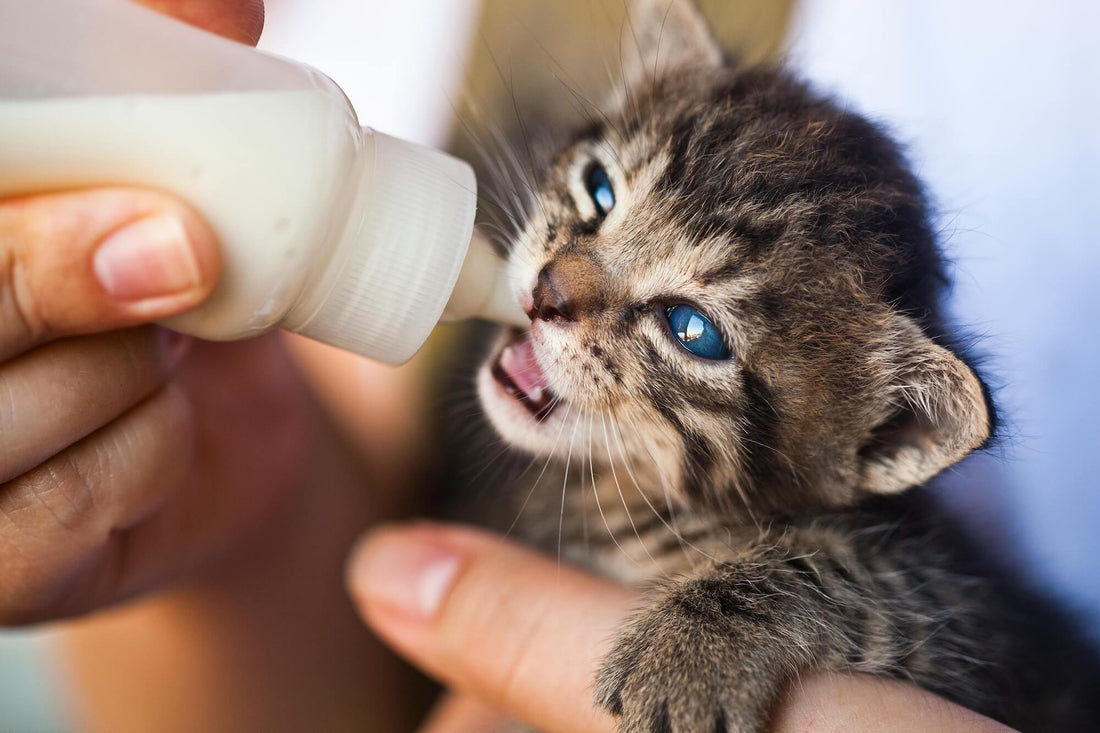How Much Should I Feed My Kitten?

Congratulations on welcoming a new member to your family! As with any new pet, you want to make sure you are meeting their every need, keeping them happy and healthy.
At the top of the list is providing them with an appropriate amount of food, supporting their development into an adult cat. From delicious wet food to nutritious dry food, find out exactly how much food you should feed your kitten.
When do kittens start eating food?
At around three to four weeks old, you can start to transition your kitten from cat milk to solid food. The weaning process can take a couple of weeks to complete. Start by feeding them a mixture of kitten food and cat milk, making it easy for them to lap up. By the time they reach seven to eight weeks old, they should be able to eat wet and dry food without any issues. At this age, their teeth should be developed enough for crunchy kibble.
What can kittens eat?
Once they are old enough, your kitten will need a diet rich in vitamins and nutrients.
Dry kitten food
Dry kitten food offers a balanced blend of proteins, vitamins and minerals, all of which play an important role in the growth of your kitten. Due to the crunchy nature of dry food, it is also believed to minimise the buildup of plaque and tartar, improving the dental health of your kitten one bite at a time.
At Burns, we have recently launched a range of dry food. Containing all 11 essential amino acids, our food has been developed to support the growth and development of kittens. Our dry food will provide your kitten with a balanced diet, just measure out their recommended daily allowance.
Wet kitten food
Wet kitten food offers a readily digestible option for young kittens. Its high moisture content makes it nice and easy to chew, while helping your kitten to stay hydrated. If your kitten happens to have dental sensitivity, wet food serves as an ideal solution, ensuring they continue to get the nutrients they need.
Fish and cooked meat
Fish or cooked meat offers some variety to your kitten’s diet. From salmon and tuna to chicken and turkey, these can be added to your kitten’s food bowl as a treat. However, these types of food can alter the balance of the nutrients, so should only make up a small portion of your kitten’s diet. Their primary source of nutrients should come from wet or dry food.
What can kittens not eat?
When feeding kittens, there are a number of foods to avoid that could be harmful to their health.
Milk
Milk can cause a number of gastrointestinal issues, such as bloating and diarrhoea. While it can seem like a good idea, cats and kittens are actually lactose intolerant. The only milk that a kitten can safely consume is its mother’s milk.
Raw eggs
Raw eggs can contain harmful bacteria, such as salmonella. This can cause severe gastrointestinal infections in kittens. Even raw egg whites can prove problematic, as they contain avidin. This protein can interfere with the absorption of biotin, leading to skin and coat issues.
Raw meat and bones
Raw meat and bones can carry harmful bacteria, which can put the health of your kitten at risk. Bones can also be incredibly dangerous for your kitten to eat. Not only could a bone break your kitten’s baby teeth, but it could also splinter into sharp fragments. If your kitten was to ingest these fragments, it could lead to internal injuries.
What to look for on kitten food labels?
When choosing what to feed your kitten, it is important to look at the food labels. Look for a recipe or “composition” that is easy to understand so that you know exactly what is in your kitten’s food. Avoid ingredients such as “meat & animal derivatives” which are vague, and you do not know what is in the food. If it says the food is complete, it will have all the nutrients your kitten needs.
Protein
Protein is incredibly important for kittens and adult cats. When there is not enough protein in your cat’s diet, you may notice their activity levels decrease. In fact, a lack of protein can even cause muscle degradation, which can significantly impact the growth and development of your kitten.”
Fat
Fat is essential for the overall health of young cats. A good quality fat will provide an invaluable source of omega 3 and omega 6. This will help your cat to grow a gorgeous glossy coat, keeping them looking and feeling their best.
Amino acids
Amino acids are vital to the development of kittens. The majority of species only need 9 amino acids. However, kittens and cats need 11. The additional amino acids are taurine and arginine, which are essential for normal heart function and brain development.
What is the difference between kitten and adult cat food?
There are a number of differences between kitten and cat food, with each designed to meet the needs of your furry friend at various stages of their life.
Kitten food typically contains higher levels of protein, fat and calories. This is to support their higher energy levels, as they run around the house and chase after their toys. It also supports growth, allowing them to develop strong bones and a healthy heart.
Cat food usually contains lower levels of protein, fat and calories. Once cats reach their full size, they will no longer need food that supports growth. Instead, they will need food that helps them to maintain their size and weight. Feeding kitten food to an adult cat could lead to weight gain.
How much to feed a kitten?
Feeding kittens the correct amount is essential for their growth and wellbeing. However, kitten feeding amounts vary depending on their age, and weight.
Use our kitten feeding chart to find out how much food you should be giving your kitten.

